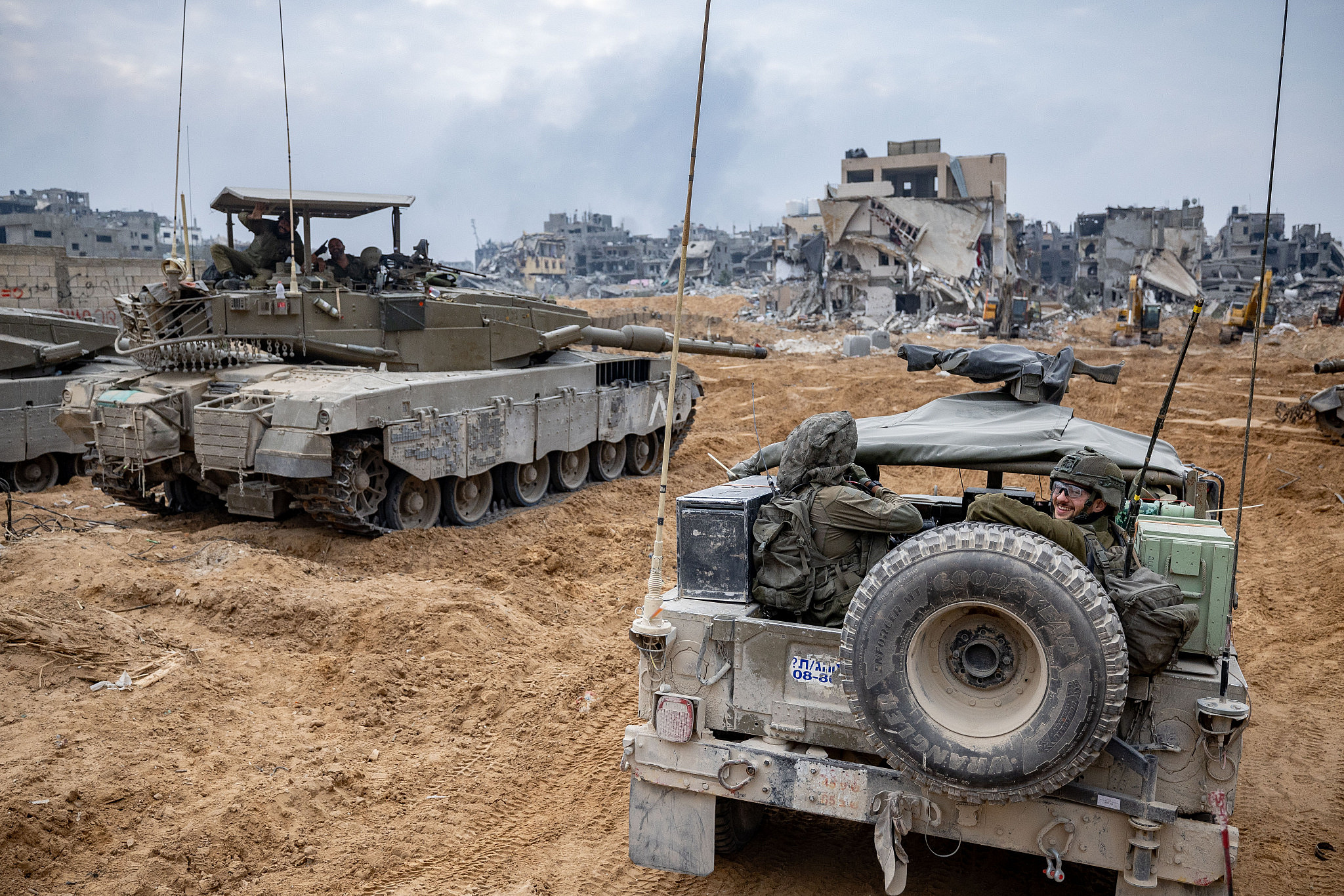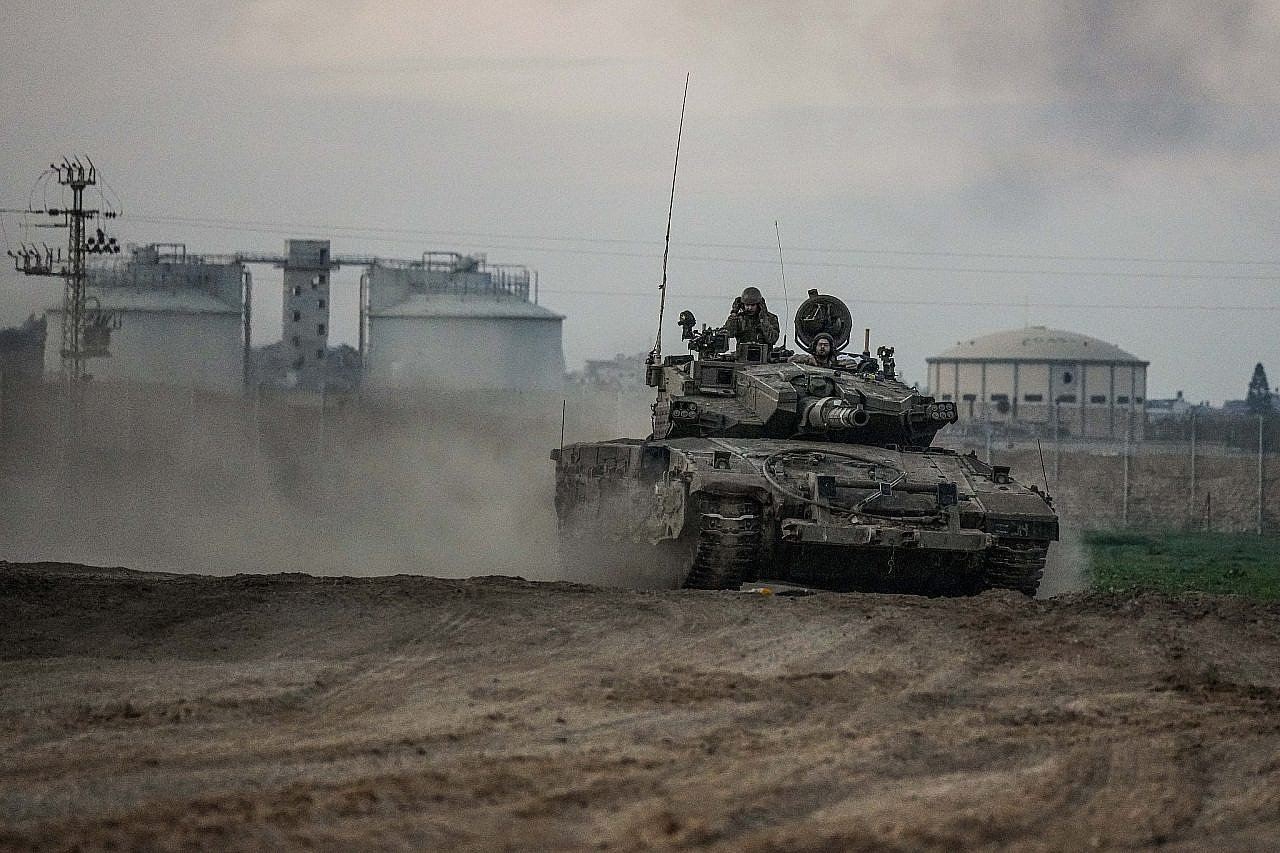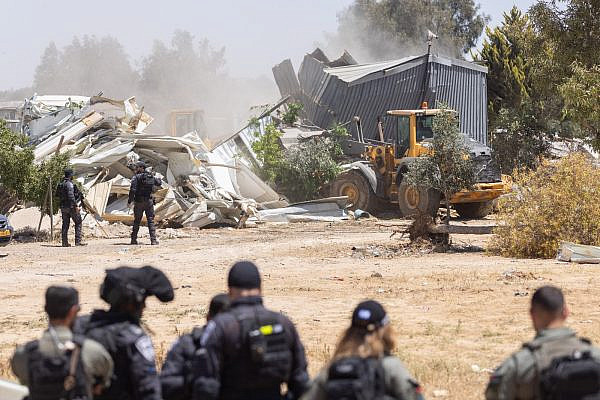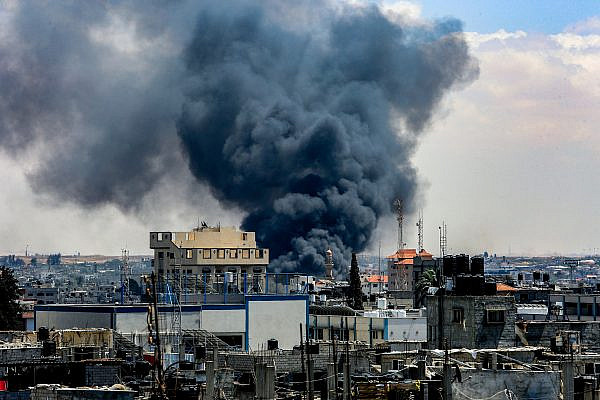On the morning of Jan. 13, a five-man crew from Paltel — a Palestinian telecommunications company that provides telephone, cellular, and internet services across the occupied West Bank and Gaza Strip — set out to repair a switchboard generator that had run out of fuel in the city of Khan Younis, in southern Gaza. The repair operation was coordinated in advance and in real time with the Israeli military, which also sent the team a detailed map of the area specifying the routes they were authorized to take. The Palestinian men completed the repair job and, by early afternoon, had set off on their return journey to the city of Rafah.
But then, without warning, an Israeli tank fired a shell directly at one of the team’s clearly-marked vehicles, killing two technicians.
In a statement to +972 Magazine and Local Call, the Israeli army confirmed that its forces fired at a Paltel team that had coordinated its entry into Khan Younis with the military. The tank, the army claimed, fired at the convoy because it had failed to follow the instructions agreed upon in advance. “The initial investigation [emphasis in the original] that was carried out indicated that the convoy crew set off on its way back without notifying the IDF, contrary to the prior coordination, and deviated from the planned and approved route. As a result, the convoy entered the sector of another force, which was not familiar with the coordination. The force identified the convoy crew as a threat and fired at them.”
However, an investigation by +972 and Local Call finds several holes in the Israeli army’s version of events. Witness testimony and video footage from the scene, along with the map that the army provided to the technicians and testimony from an Israeli intelligence source, reveal that the army killed the Paltel employees despite the team closely following instructions.
This incident did not receive nearly as much publicity as the Israeli army’s shooting of three Israeli hostages waving a white flag in December, nor the drone strikes that killed seven World Central Kitchen employees driving in clearly-marked vehicles last month. But the killing of the Paltel employees has several parallels with these other two incidents. It, too, shines a light on two recurring features of Israel’s seven-month onslaught in Gaza: the disorderly coordination between Israeli forces on the ground, and the army’s trigger-happy conduct toward anyone found inside designated “kill zones” where those forces are operating.
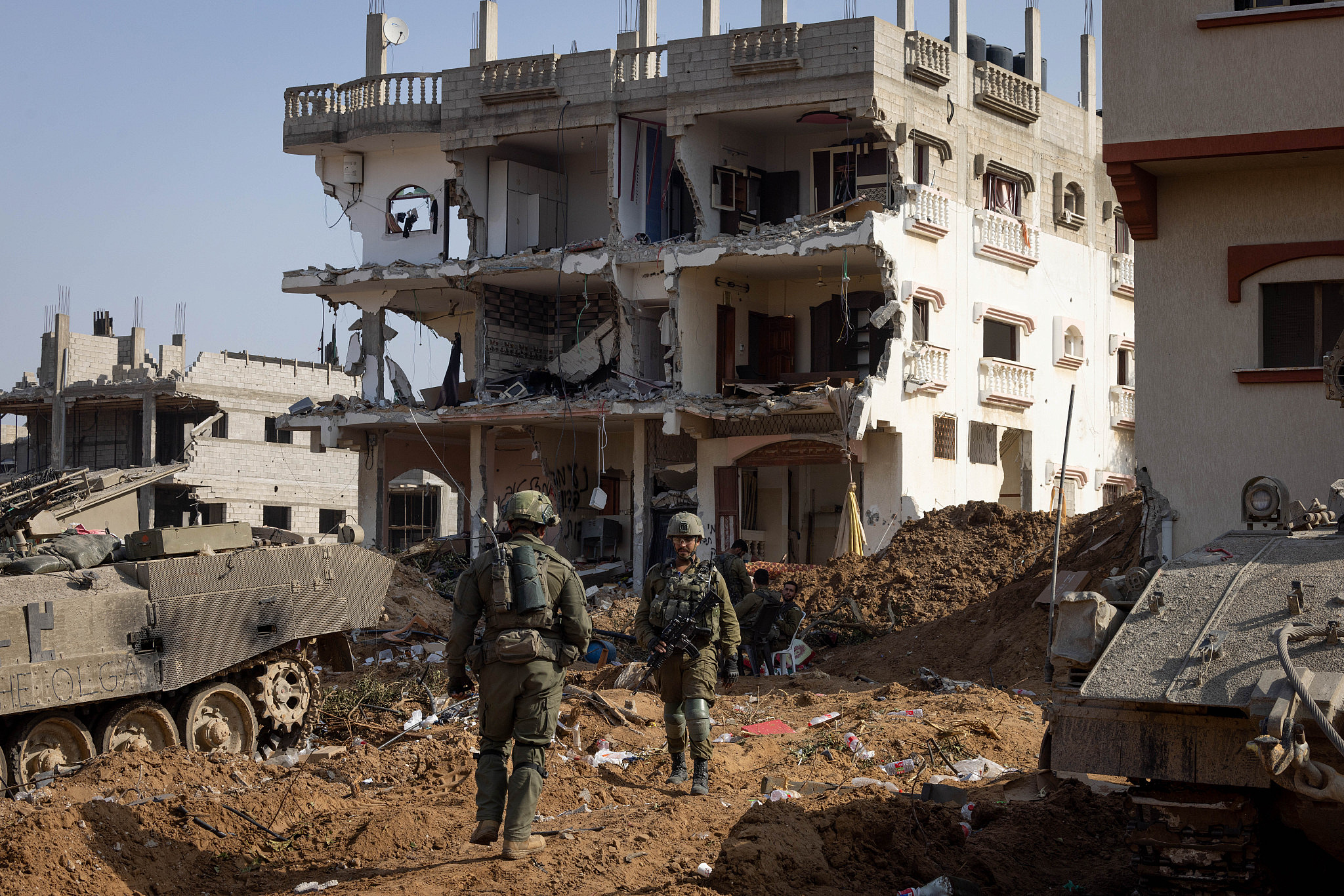
‘The army erased everything’
Early on Jan. 13, Paltel assembled a team to repair the main switchboard generator in Khan Younis after it had run out of fuel. The city, like the rest of the Gaza Strip, has been relentlessly bombed by the Israeli army and subjected to a tightened siege since October, destroying much of the territory’s infrastructure and cutting off vital services like electricity. Moreover, Israeli troops have directly occupied Khan Younis for several months, sealing off large parts of the city to Palestinians. Without the switchboard generator, all internet and phone lines from Wadi Gaza southward — more than half of the Strip — would stop working, throwing the vast majority of the population, most of them displaced, into a communications blackout.
The five-man convoy consisted of three vehicles. The first was a white car marked with company flags that was driven by Nader Abu Hajjaj (also known by his kunya, Abu Udai), an electrician, and had two passengers: Bahaa Al-Rayes, a technician who worked in Paltel’s internet and cyber department, and Ali Alsawahli, another technician. Alsawahli stepped out of the car seconds before it was shelled, surviving the attack; Hajjaj and Al-Rayes were killed in the strike.
The second vehicle in the convoy was a bulldozer, driven by Mohammed Azzam, which was needed to clear the rubble strewn across the streets of Khan Younis. Finally, behind Azzam’s bulldozer, Ibrahim Abedin drove a heavy fuel truck containing the supplies required to repair the switchboard.
Alsawahli told +972 and Local Call that since the beginning of the war, he and his colleagues have regularly repaired damaged infrastructure throughout the Gaza Strip, which he sees as life-saving work: if there is no functioning cellular service, it is impossible to call an ambulance or rescue teams. “Our work is important, humanitarian, like that of doctors or rescue workers,” he explained.
Before each repair mission, a unit from the Coordinator of Government Activities in the Territories (COGAT) — the Israeli military branch that governs civilian affairs in the occupied West Bank and Gaza — receives the technicians’ IDs and the cars’ license plate numbers, and the company receives a link on Google Maps loaded with the approved routes.

The convoy left north Rafah at 10 a.m. and set out along the marked route. According to Alsawahli, Khan Younis looked like a ghost town. He grew up in the city, but could barely recognize its streets. “The army erased the place,” he said. “We Paltel technicians have traveled all over Gaza, more than journalists. People don’t understand. [The army] just erased everything.”
Every few meters, the vehicles stopped to allow the bulldozer to clear rubble from the street. While low buildings often collapse into themselves when they are bombed, Alsawahli explained, taller buildings tend to fall into the road and block it. “The bulldozer is driving, and I’m next to it, pointing out pieces of concrete to clear,” he said.
All the while, the Paltel team was coordinating its movements with the Israeli authorities, using a satellite cellular device for which Abu Hajjaj, the driver who was killed, was responsible. The communication was indirect: Abu Hajjaj was in touch with Paltel’s coordination department, which relayed messages between the team on the ground and the army. According to Alsawahli, the team informed the coordination department before each turn along their way, and waited for permission from the army before proceeding.
‘We’re following the plan and they’re shelling?’
When the convoy reached Al-Sunneya Street, some 600 meters away from the switchboard, they heard an explosion. A residential building about 20 meters away had been hit by a shell fired from an Israeli tank. “Stones were flying at our heads and the car,” Sawaklhi said. “The coordination department told us: ‘Keep going, you’re not the target, don’t worry.’”
But the men were apprehensive. Abu Hajjaj called the coordination department again. “We were afraid to die,” recalled Alsawahli. “We’re following the plan the army gave us, and they’re shelling? What is this?” The crew got out of their vehicles and gathered on the side of the road to wait for the shelling to subside. After 10 minutes, they called the coordination department once more and received permission to continue.
Before they got back into their vehicles, Alsawahli suggested that the team take a selfie. In the photo, Alsawahli holds the phone, smiling from ear to ear, while the rest of the group looks rather more serious. This is the last photo of Abu Hajjaj, who is seen in the center wearing a hat and looking away from the camera, and Al-Rayes, who is wearing glasses and stands on the far right.

In the background of the photo is the faded sign of Accumed medical laboratory for genetic diseases. This spot is also along the pre-approved route. (Two months later, the Accumed laboratory was completely destroyed).
When Paltel’s men were just 150 meters from the switchboard, they reached a small square, and a group of Israeli soldiers appeared in front of them. “There’s one sentence I remember in Hebrew: ‘I’m unarmed.’ I learned this from the radio, at the beginning of the war,” Alsawahli said. He bared his stomach, raised his hands, and said the only sentence he knew. The officer shouted something at him, but Alsawahli didn’t understand. “He speaks to me in Hebrew, with all the soldiers pointing at me with lasers. Six or seven weapons with lasers on my chest,” Alsawahli recalled.
An Arabic-speaking soldier then approached Alsawahli and asked him what they were doing in a combat zone. Alsawahli explained their reason for traveling to Khan Younis, but as he was doing so, he realized that the soldiers did not know about the coordination between them and the military.
The unit handcuffed the five technicians and took their ID cards to “check.” While handcuffed, Alsawahli chatted with the Arabic-speaking soldier, who told him that his mother is from Lebanon, and that he had learned Arabic from her. The soldier then offered Alsawahli a cigarette. An hour later, after confirming that the five men were a pre-approved team of Paltel employees, the soldiers released the technicians and they went on their way.
At around 12:30 p.m., the crew arrived at the switchboard — which is located underground, so that in case of a bombing, it is less likely to be damaged. The walls of the building’s upper floor had collapsed after an Israeli airstrike. Alsawahli tried to make his way to the office in the building where he had worked before the war, in order to find a laptop he had left there, but the debris made it impossible to even reach the ruins of the office. Downstairs at the switchboard, and with great difficulty, the team filled the generators with fuel.
When they finished, Abu Hajjaj got permission from the coordination department and was told that they should return the way they came. The team passed the group of Israeli soldiers again. “The soldiers waved goodbye to me, and I waved back to them, and I laughed,” Alsawahli recalled. “It’s in my nature to laugh and smile. They motioned to me to drive on. And we continued.”
‘Do you think we want to go to our death?’
On the way back to Rafah, the Paltel team passed the neighborhood in Khan Younis where Alsawahli had lived before the war. He lived in Al-Fara Tower, an 18-story building. The Israeli military had shelled the area intensively, shattering all the windows in the tower.
“I went into my apartment afterward, saw glass, everything on the floor, and my wife and children crying,” Alsawahli recounted of the day the area was attacked. “I told them: ‘Come, we’re leaving. Nothing, no clothes even.’” Alsawahli has three children, a 10-year-old girl and two boys, aged 9 and 3.
Later, the army toppled the tower, which was the tallest in Khan Younis and considered a local symbol. It may have been designated as a “power target,” which, according to prior investigations by +972 and Local Call, the military marked for airstrikes in order to create psychological pressure on Gaza’s civilian population, which it hoped would, in turn, apply pressure on the Hamas leadership. Now Alsawahli lives with his displaced family in a tent by the beach.
Shortly before Paltel’s convoy was due to leave the dangerous area, they had to stop. The minaret of Khan Younis’ Grand Mosque, which still stood 30 meters high when they passed it in the morning, had since fallen onto the road and blocked it. At around 2 p.m., Alsawahli went down to see if there was another road bypassing the minaret, and Abu Hajjaj held the walkie-talkie high in the air so there would be reception to notify the coordination department of a potential need to alter the route.
Then, Alsawahli saw an Israeli tank standing on the other side of the fallen minaret. “I heard an explosion, and I felt like I had fainted,” he says. The tank had fired. The team’s white car was directly hit.
A video taken by Alsawahli a few minutes after the shelling shows Paltel’s white vehicle on fire in front of Al-Qal’a, a local bakery. Alsawahli mumbles the Shahada, the Islamic declaration of faith, which Muslims often recite when facing or encountering death. “Abu Udai and Bahaa died,” he says, “a tank shot at us.” Then more gunfire is heard, and the video abruptly ends. It is 11 seconds long.
The location of the Al-Qal’a Bakery, named after a nearby Mamluk-era fortress, and the shape of the windows of the buildings on the street, allow us to locate the exact spot where Alsawahli documented the incident. +972 and Local Call cross-checked this location with the map sent by the Israeli military specifying the route the Paltel team was to take (the army refused to provide a copy of this map upon request, but we obtained a copy from Paltel). From the map, it can be determined that the technicians were on the pre-approved route when they were hit.
However, in the video, the wheels of the burning vehicle can be seen pointing left, toward the Grand Mosque of Khan Younis, even though, according to the map, the vehicle should have turned right at this intersection, towards Sea Street. Speaking to +972 and Local Call, Alsawahli explained that they wanted to turn right but couldn’t: rubble from houses that had been bombed was completely blocking the road, and the bulldozer would have been unable to clear it. According to him, the military informed them in the morning that they would have to turn left at the intersection, contrary to what was written on the map.
“We don’t move without coordination and clear instructions,” Alsawahli said, “Do you think we want to go to our death? Everything was done in coordination. We didn’t move a meter without notifying the army and getting approval.”
After the shelling of the car, Alsawahli crawled through shards of glass to get to the diesel truck, which was not hit, and looked at the burning white vehicle. “My two friends were burned in front of me and I couldn’t get them out,” he recalled, his voice shaking.
According to Alsawahli, the soldiers in the tank continued firing for many minutes. The drivers of the bulldozer and the truck, Azzam and Abedin, lay wounded on the ground. Alsawahli found a piece of cloth and wrapped Azzam’s head, attempting to stop the bleeding, and then filmed the video described earlier. He said he felt the need to film the scene, not knowing exactly why.
The three survivors decided to try to crawl toward the sea. The minaret hid them from the shooters, who kept raining fire. After crawling a few dozen meters, the Paltel workers started running. “There was no one in town,” Alsawahli said. “Everything was ruined. The whole city was full of zananat [drones]. We ran until we got to Nasser Hospital. And there I fainted.”

‘All that remained were his stomach and chest’
Initiated following the Hamas-led October 7 attack, Israel’s ongoing assault on the Gaza Strip, codenamed “Operation Iron Swords,” has been unprecedented in its ferocity. It has killed over 34,000 Palestinians in the besieged territory, a third of them children, and destroyed much of the Strip’s housing units and public infrastructure through relentless airstrikes, shellings, and ground incursions.
A contributing factor to this unparalleled death and devastation has been the Israeli army’s trigger-happy policy in Gaza, combined with a widespread disregard for distinguishing between military and civilian targets. In late March, for example, Haaretz reported that commanders had authorized troops on the ground to shoot anyone found to be in designated “kill zones” who was not an Israeli soldier, without verifying who the individuals were or why they were in the area. As the political sociologist Yagil Levy described to +972 and Local Call in February, “Any talk of restraint is a dirty word.”
Officials within the Israeli military are aware of the attack on the Paltel crew, and admit that the workers should not have been fired on. The army noted to +972 and Local Call that they had referred the case for further investigation in the future. However, given the record of systemic impunity that has long characterized Israeli military conduct toward Palestinians, army probes are unlikely to yield any real accountability for the killings.
“I know they were not supposed to have been shot. I know there was coordination. And I know they were shot anyway,” an intelligence source familiar with the case told +972 and Local Call. “When this happened, people here in Modi’in (Military Intelligence) were upset. I was furious about it. I thought, ‘You killed innocent people doing important work.’ But it didn’t seem to bother anyone.”
The source also said that Israel actually has tactical military interests in keeping the cellular network in the Gaza Strip intact. “We expected them to fix [the switchboard],” said the source, “[but] soldiers on the ground just opened fire.”
Most read on +972
It was not until a few days later that the Israeli military authorized the collection of Abu Hajjaj and Al-Rayes’s bodies from the burned vehicle. Their bodies were charred, and the hospital struggled to tell them apart. Alsawahli insisted on seeing them, even though the doctor advised him not to. “I had to see them, because I was one of them,” he said.
The doctor opened the body bag, and Alsawahli recognized them immediately. “That’s Nader [Abu Hajjaj]. He was sitting next to me and the shell hit him directly. He had no head, no arms, no legs. All that remained were his stomach and chest, burned.
“That’s Bahaa,” Alsawahli continued. “He sat behind me. He had a head. He had no arms and legs, but he had teeth. I recognized him because of his teeth.”
After his conversation with +972 and Local Call, Alsawahli disappeared for a week and stopped answering our messages. When he returned, he explained that living with his family in the tent is extraordinarily difficult, and that his biggest concern right now is finding water and food for the family. He sent us a photo of the tent compound where he now lives, in Al-Mawasi.

Alsawahli lamented how, before the war, Abu Hajjaj used to come to his apartment in Khan Younis every morning to drink tea and smoke cigarettes before work. “I loved him more than a colleague,” he said. “I feel like I died with them.”

